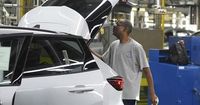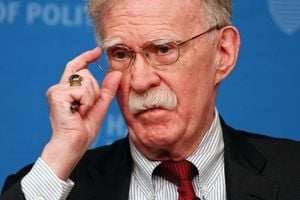Inflation has once again taken center stage in the U.S. economy, with July 2025 marking a pivotal moment for policymakers, investors, and everyday Americans alike. According to data released by the Labor Department’s Bureau of Labor Statistics and reported by multiple outlets including AINVEST and the Associated Press, the U.S. producer price index (PPI) surged 0.9% in July, the largest monthly increase since June 2022. On a year-over-year basis, wholesale prices are now up 3.3%, a figure that caught economists off guard and signaled the growing influence of President Donald Trump’s aggressive tariff agenda.
These inflationary pressures are not merely statistical quirks. They’re a direct outgrowth of trade policies that have upended global supply chains and left both businesses and consumers bracing for higher costs. Tariffs on steel, aluminum, and other imports now average 15.8%, with some sector-specific rates climbing as high as 50%. The Trump administration has also signaled the possibility of 200% tariffs on pharmaceuticals by mid-2026, a move that could ripple through the healthcare and technology sectors.
The impact of these tariffs is already being felt in key industries. For example, the 50% tariffs on steel and aluminum have pushed U.S. Midwest premium aluminum prices to the brink, with spot prices barely covering the cost of the duties, according to AINVEST. Meanwhile, the semiconductor industry is facing mounting uncertainty as the administration’s tariff threats loom large over the global supply of critical components. J.P. Morgan estimates that the current tariff regime could add between 1 and 1.5 percentage points to U.S. inflation by the end of 2025, a sobering prospect for households already contending with elevated prices.
But the effects aren’t confined to the United States. As China, Brazil, and the European Union respond with their own retaliatory tariffs, global GDP growth is projected to fall by 1% in 2025. The result is a fractured world trading system, where supply chain disruptions and rising costs have become the new normal. Companies once reliant on seamless international supply lines are now rethinking their strategies, stockpiling raw materials such as copper to preempt further tariff hikes.
For investors, this environment has necessitated a shift in strategy. Inflation-protected securities, or TIPS, have emerged as a critical hedge. As of August 2025, the 10-year TIPS yield stood at 1.8%, with breakeven inflation expectations at 2.1%—right in line with the Federal Reserve’s 2% target. Yet, as AINVEST points out, these numbers may mask deeper tensions between short-term disruptions and long-term inflation risks. The lag between producer and consumer inflation means that households could soon face even higher costs as businesses begin to pass on their increased expenses.
Indeed, the current inflation surge is already showing up in specific categories. Wholesale food prices jumped 1.4% from June to July, driven by a staggering 38.9% increase in vegetable prices. Home electronic equipment, another heavily imported category, saw prices rise 5% month-over-month. While some businesses are still absorbing the higher costs associated with tariffs, there’s little doubt that these expenses will eventually filter down to consumers. As Christopher Rupkey, chief economist at fwdbonds, put it in commentary cited by the Associated Press, “It will only be a matter of time before producers pass their higher tariff-related costs onto the backs of inflation-weary consumers.”
The inflation story isn’t just about tariffs, of course. The broader commodity complex has also played a role. The Bloomberg Commodities Roll Select Total Return Index gained 9.16% in the first quarter of 2025, with gold and silver prices surging 18.2% and 18.5%, respectively. Copper, a bellwether for industrial demand, saw prices rise over 25% amid supply concerns and U.S. stockpiling. Even agricultural commodities have not been immune: coffee prices jumped 22% due to production constraints in Brazil and Vietnam, while natural gas surged 11% thanks to cold weather and supply disruptions. Meanwhile, the S&P Global Infrastructure Index rose 4.4% in Q1 2025, buoyed by declining interest rates and pro-growth policies.
Despite these headwinds, not all companies are suffering equally. Firms like Ford and Tesla, which rely less on global supply chains, have outperformed more import-dependent peers. Their ability to weather the storm is a testament to the importance of supply chain resilience in a world of rising trade barriers. As tariffs become a fixture rather than a temporary measure, companies that can insulate themselves from global shocks are likely to fare best.
The Federal Reserve finds itself in a difficult position. The central bank had been widely expected to cut interest rates at its September 2025 meeting in a bid to recharge hiring after a disappointing July jobs report. However, the unexpectedly strong inflation data has complicated that calculus. Carl Weinberg, chief economist at High Frequency Economics, wrote in commentary that “This report is a strong validation of the Fed’s wait-and-see stance on policy changes. It will mean a markdown of market expectations for a September rate cut.”
The uncertainty is compounded by political drama at the Bureau of Labor Statistics, which has come under fire from President Trump after releasing jobs data that did not align with his administration’s narrative. After firing the BLS director and nominating a partisan successor, Trump has raised fears of political interference in the economic data that investors, policymakers, and businesses rely on.
Legal challenges to the administration’s use of the International Emergency Economic Powers Act (IEEPA) to justify sweeping tariffs have added another layer of volatility. If courts strike down these tariffs, it could upend business planning and market expectations overnight. In the meantime, businesses are left guessing about where tariff rates will ultimately land, and whether they should adjust their own prices now or wait for more clarity.
Against this backdrop, diversification has become the watchword for investors. AINVENT advises prioritizing a mix of inflation-protected securities, diversified commodity exposure, and real assets like infrastructure and REITs. The message is clear: in an era of deglobalization and persistent trade tensions, adaptability and diversification are not just advantages—they are necessities.
Looking ahead, the interplay of tariffs, supply chain disruptions, and inflationary pressures will continue to shape the economic landscape. The Federal Reserve’s “higher for longer” rate stance may complicate short-term market dynamics, but the long-term risks of trade-war-driven inflation remain significant. For households, businesses, and investors, the ability to adapt—whether by rotating into sectors insulated from tariffs or hedging against currency volatility—will be critical to surviving and thriving in this new era of economic uncertainty.
As global trade tensions persist and inflationary pressures mount, the coming months will be a test of resilience for both markets and Main Street. The winners will be those who can anticipate change, diversify wisely, and respond nimbly to a world that looks far less predictable than it did just a few years ago.





